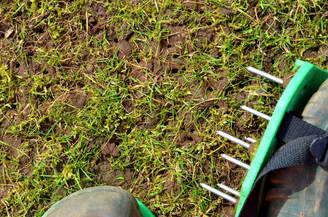 Is my soil compacted? You should know that soil compaction is the main reason for an unhealthy lawn. Aerating can aid in relieving soil compaction, and spring is a great time to do it. Aerating your lawn accomplishes a couple of things:
Regular aeration also lessens the buildup of thatch, which is a layer of stems, leaves, and dead roots. Some thatch is good because it gives a cushion and some defense to the roots. Though, more massive thatch buildup decreases nutrient and water absorption and can overpower the roots. Soil compaction is a common reason for a stressed lawn. If your grass gets lots of traffic, it will best stay alive if it is aerated every six to 12 months. Also, heavy clay soil necessitates repeated aerating. Lawns grown on sandy soil or getting light traffic can be aerated every 12 months or every 24 months. Cool-season grasses like ryegrass, fescues, and bluegrass, grow most steadily in the fall. A single aerification is best done then. Though, if the soil is very compacted, aerating in the spring is okay. Moreover, if your lawn is thinned out because of disease or winter damage, aerating before fertilizing and the seedling will assist your lawn in thickening up very fast. Core Aerating Core aerating is using a machine to remove plugs of soil. This is the simplest way to perform aeration. Also, hand aerators are available. But in most instances, a machine is much simpler and will perform better. You can rent these aerators at some garden centers. The soil must be moist but not wet to aerate. A sandy soil must be lightly watered the day before you plan to aerate. It is recommended heavy clay soil be watered at least two days before. The plugs/cores left behind by the aerator can be removed, but don’t have to be. In a couple of weeks, they will decompose with traffic and weather. If you would like to speed up the process, pull a mat across the lawn to break down the cores. Don’t want to manage your aeration job? Reach out to a York tree service company instead. Comments are closed.
|
© Tree Service York PA 2016-2020
Leaders Heights | Jacobus | Emigsville | Mount Wolf | Manchester| Marietta | Bainbridge | Wrightsville | Dallastown |Windsor | East Prospect |York Haven | Red Lion | Dover | Loganville | Seven Valleys
Tree Service York PA
2536 Eastern Blvd #102
York, PA 17402
(717) 216-4888
2536 Eastern Blvd #102
York, PA 17402
(717) 216-4888
